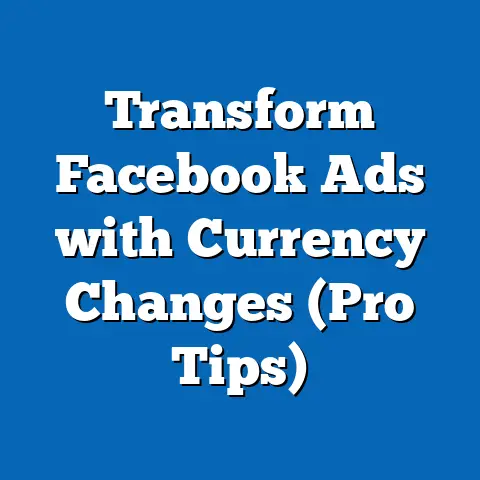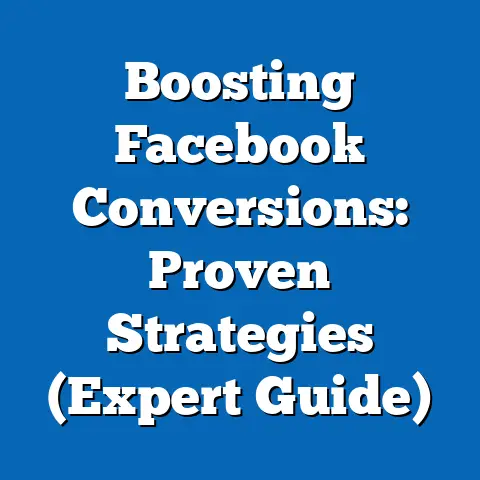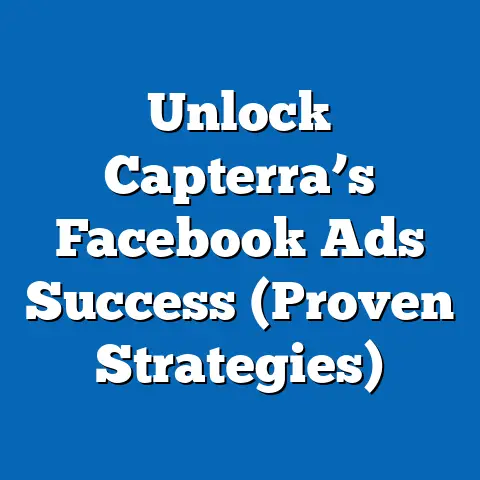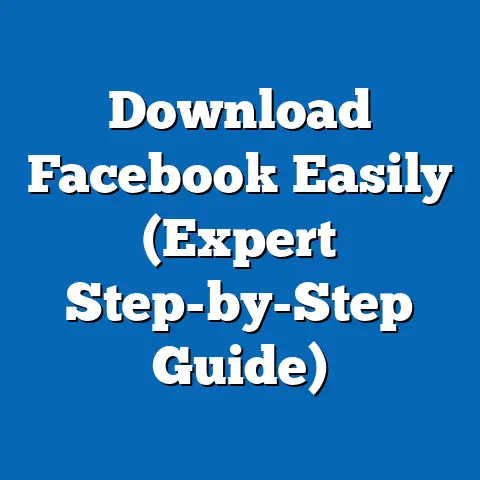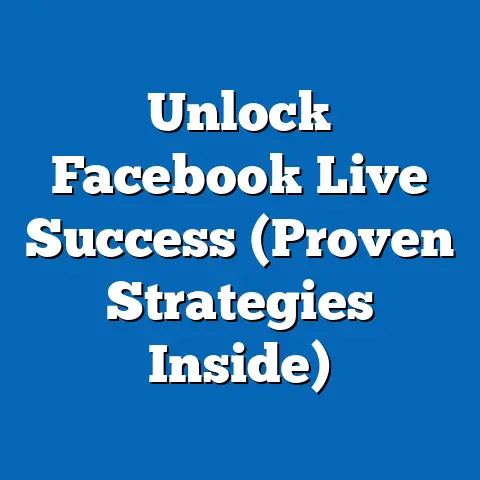Unlock Facebook Ads for Lead Generation (Expert Strategies)
In today’s digital age, generating leads is the lifeblood of any successful business. And when it comes to reaching a vast and engaged audience, Facebook Ads stands out as a powerhouse. I’ve seen firsthand how businesses, both big and small, have transformed their lead generation efforts by strategically leveraging Facebook’s advertising platform. What’s truly remarkable is how accessible it is – the ease of installation and setup makes it a viable option for everyone, from solopreneurs to large enterprises.
The potential return on investment (ROI) with Facebook Ads is significant, but it requires a thoughtful approach. It’s not just about throwing money at ads and hoping for the best. It’s about understanding the platform, crafting compelling content, targeting the right audience, and constantly optimizing your campaigns. In this guide, I’ll share expert strategies that I’ve honed over years of experience to help you unlock the full potential of Facebook Ads for lead generation. Let’s dive in!
Understanding Facebook Ads
Facebook Ads are, at their core, a way to promote your business and reach potential customers on the world’s largest social media platform. They come in various formats, each designed to capture attention and drive engagement.
- Image Ads: These are simple yet effective ads featuring a single image and accompanying text.
- Video Ads: Video ads are incredibly engaging and allow you to tell a story or demonstrate your product in action.
- Carousel Ads: These ads display multiple images or videos in a scrollable format, allowing you to showcase different products or features.
- Collection Ads: Designed for e-commerce, these ads feature a main image or video with a collection of products displayed below.
- Lead Ads: Specifically designed for lead generation, these ads allow users to submit their information directly within Facebook, without having to leave the platform.
The true power of Facebook Ads lies in its targeting capabilities. You can target users based on a wide range of factors, including:
- Demographics: Age, gender, location, education, and more.
- Interests: Hobbies, passions, and topics they follow on Facebook.
- Behaviors: Purchase history, online activity, and device usage.
- Connections: People who like your page, friends of people who like your page, and more.
Why is Defining Your Target Audience Important?
Defining your target audience is paramount to lead generation success. Imagine trying to sell winter coats to people living in a tropical climate – it’s simply not going to work. By clearly defining your target audience, you can ensure that your ads are shown to the people who are most likely to be interested in your products or services. This not only increases your chances of generating leads but also helps you optimize your ad spend by avoiding wasted impressions.
Facebook Ads offers various campaign objectives to choose from, ranging from brand awareness to sales conversions. When your primary goal is lead generation, selecting the “Lead Generation” objective is crucial. This tells Facebook’s algorithm that you want to collect leads, and it will optimize your ads to achieve that goal.
Key Takeaway: Facebook Ads offer a diverse range of formats and targeting options, making them a powerful tool for lead generation. Defining your target audience and selecting the right campaign objective are essential for success.
Setting Up Your Facebook Ads Account
Before you can start running Facebook Ads, you’ll need to set up a Facebook Ads account. Here’s a step-by-step guide:
- Create a Facebook Business Manager Account: If you don’t already have one, go to business.facebook.com and create a Business Manager account. This is a central hub for managing your Facebook pages, ad accounts, and other business assets. I’ve found that keeping everything under one Business Manager simplifies the management process immensely.
- Add Your Facebook Page: Within Business Manager, add your Facebook page. This is the page that your ads will be associated with.
- Create an Ad Account: In Business Manager, create an ad account. You’ll need to provide some basic information about your business, such as your name, address, and time zone.
- Set Up Payment Information: Add your payment information to your ad account. Facebook accepts various payment methods, including credit cards and PayPal.
- Install the Facebook Pixel: The Facebook Pixel is a small piece of code that you place on your website to track conversions and optimize your ad performance. To install the Pixel, go to the “Pixels” section in Ads Manager, create a Pixel, and follow the instructions to add the code to your website.
Navigating the Ads Manager Interface
The Ads Manager interface can seem daunting at first, but it’s actually quite intuitive once you get the hang of it. Here are some key features to familiarize yourself with:
- Campaigns: This is where you create and manage your ad campaigns.
- Ad Sets: Ad sets define your target audience, budget, and schedule.
- Ads: This is where you create your individual ads, including the headline, image, and ad copy.
- Audience Insights: This tool provides valuable insights into your target audience, including their demographics, interests, and behaviors.
- Performance Metrics: Ads Manager provides a wealth of performance metrics, such as impressions, clicks, CTR, conversion rates, and cost per lead.
The Importance of the Facebook Pixel
I cannot stress enough the importance of installing the Facebook Pixel on your website. It’s the key to tracking conversions, optimizing your ad performance, and retargeting users who have interacted with your website. Without the Pixel, you’re essentially flying blind.
Key Takeaway: Setting up your Facebook Ads account involves creating a Business Manager account, adding your Facebook page, creating an ad account, and installing the Facebook Pixel. Familiarize yourself with the Ads Manager interface to effectively manage your campaigns.
Crafting Compelling Ad Content
The content of your ads is crucial for capturing attention and driving engagement. Here are some key elements of high-performing ad content:
- Eye-Catching Visuals: Use high-quality images or videos that are relevant to your target audience and your offer. Avoid using generic stock photos – instead, opt for visuals that are authentic and engaging. I’ve found that using images of real people tends to perform better than using product shots.
- Persuasive Headline: Your headline is the first thing people will see, so it needs to be attention-grabbing and compelling. Use strong verbs and highlight the benefits of your offer. For example, instead of saying “Learn More About Our Product,” try “Discover How Our Product Can Solve Your Biggest Problem.”
- Engaging Ad Copy: Your ad copy should expand on your headline and provide more details about your offer. Focus on the benefits of your product or service and explain how it can solve your target audience’s problems. Use clear and concise language that is easy to understand.
- Strong Call-to-Action (CTA): Your CTA should clearly tell users what you want them to do. Use action-oriented language such as “Sign Up Now,” “Download Now,” or “Get Your Free Trial.” Make sure your CTA is visually prominent and easy to click.
Examples of Successful Lead Generation Ads
Let’s take a look at some examples of successful lead generation ads and analyze what makes them effective:
- Example 1: HubSpot’s Free Marketing Grader: HubSpot uses a simple image of a laptop with the headline “Get Your Free Marketing Grader.” The ad copy explains that the tool will help users identify areas where their marketing efforts can be improved. The CTA is “Get Your Score.” This ad is effective because it offers a valuable free tool that is relevant to HubSpot’s target audience.
- Example 2: Neil Patel’s SEO Analyzer: Neil Patel uses a video of himself explaining the benefits of his SEO analyzer tool. The ad copy highlights the tool’s ability to identify SEO issues and provide actionable recommendations. The CTA is “See My SEO Score.” This ad is effective because it leverages Neil Patel’s personal brand and provides a clear value proposition.
- Example 3: Monday.com’s Project Management Tool: Monday.com uses a visually appealing image of their project management tool in action. The headline is “Manage Your Projects With Ease.” The ad copy explains how the tool can help teams collaborate and stay organized. The CTA is “Get Started.” This ad is effective because it showcases the tool’s functionality and highlights its benefits.
Key Takeaway: Crafting compelling ad content involves using eye-catching visuals, persuasive headlines, engaging ad copy, and a strong CTA. Analyze successful lead generation ads to identify what works and adapt those strategies to your own campaigns.
Targeting Your Audience Effectively
Reaching the right audience is crucial for lead generation success. Facebook Ads offers a variety of advanced targeting options to help you narrow down your audience and reach the people who are most likely to be interested in your products or services.
- Custom Audiences: Custom audiences allow you to target users based on your existing data, such as website visitors, email lists, or engagement with previous ads. This is a powerful way to retarget users who have already shown an interest in your business.
- Lookalike Audiences: Lookalike audiences allow you to reach new potential leads who resemble your existing customers. Facebook will analyze your custom audience and identify users who share similar demographics, interests, and behaviors. This is a great way to expand your reach and find new leads.
- Retargeting: Retargeting involves showing ads to users who have previously interacted with your website or ads. This is a highly effective strategy because these users are already familiar with your brand and are more likely to convert.
Creating a Custom Audience
To create a custom audience, go to the “Audiences” section in Ads Manager and click “Create Audience.” You can then choose from a variety of sources, such as:
- Website Traffic: Target users who have visited specific pages on your website.
- Customer List: Upload a list of your customer email addresses or phone numbers.
- App Activity: Target users who have interacted with your mobile app.
- Engagement: Target users who have engaged with your Facebook page or ads.
Using Lookalike Audiences
To create a lookalike audience, select your custom audience as the source and choose the size of the lookalike audience. Facebook will then create a new audience that resembles your custom audience.
The Importance of Continuous Audience Testing and Refinement
I’ve learned that audience targeting is not a “set it and forget it” process. You need to continuously test and refine your audience to improve your lead generation efforts. Try experimenting with different targeting options and monitor your ad performance to see what works best.
Key Takeaway: Effective audience targeting involves using custom audiences, lookalike audiences, and retargeting. Continuously test and refine your audience to improve your lead generation efforts.
Optimizing Your Campaign for Success
Once you’ve set up your Facebook Ads campaign and started running ads, it’s important to continuously optimize your campaign for success. Here are some key strategies:
- A/B Testing: A/B testing involves testing different variations of your ads to see which ones perform best. Try testing different headlines, images, ad copy, and CTAs. Use the data you collect to optimize your ads and improve your lead generation efforts. I typically run multiple A/B tests simultaneously to quickly identify winning combinations.
- Analyzing Ad Performance Metrics: Pay close attention to your ad performance metrics, such as impressions, clicks, CTR, conversion rates, and cost per lead. These metrics will give you valuable insights into how your ads are performing and where you can make improvements.
- Optimizing Ad Spend: Adjust your budgets and bids based on performance. If certain ads are performing well, increase their budgets. If other ads are underperforming, decrease their budgets or pause them altogether.
- Retargeting Ads: Retarget users who have interacted with previous campaigns but did not convert. Show them ads that are specifically tailored to their interests and needs.
Understanding Key Metrics
- Click-Through Rate (CTR): The percentage of people who see your ad and click on it. A higher CTR indicates that your ad is relevant and engaging.
- Conversion Rate: The percentage of people who click on your ad and then complete a desired action, such as signing up for a newsletter or downloading a free resource. A higher conversion rate indicates that your landing page is effective and your offer is compelling.
- Cost Per Lead (CPL): The amount of money you spend to acquire one lead. A lower CPL indicates that your campaign is efficient and cost-effective.
Key Takeaway: Optimizing your campaign for success involves A/B testing, analyzing ad performance metrics, optimizing ad spend, and retargeting ads. Continuously monitor your campaign and make data-driven decisions to improve your lead generation efforts.
Conclusion
Facebook Ads are a powerful tool for lead generation, offering a vast reach and sophisticated targeting options. The ease of installation and setup makes them accessible to businesses of all sizes. By understanding the platform, crafting compelling content, targeting the right audience, and continuously optimizing your campaigns, you can unlock the full potential of Facebook Ads and generate a steady stream of high-quality leads.
Don’t be afraid to experiment and try new things. The digital marketing landscape is constantly evolving, so it’s important to stay up-to-date on the latest trends and best practices. Embrace the challenge and leverage Facebook Ads as a vital component of your lead generation strategy.
I encourage you to share your experiences with Facebook Ads in the comments below. What strategies have worked well for you? What challenges have you faced? I’m always eager to learn from others and share insights. If you have any questions about implementing the strategies discussed in this article, please don’t hesitate to reach out.
Call to Action: Share your experiences with Facebook Ads in the comments below or reach out with questions about implementing the strategies discussed in the article. Your insights could help others unlock the power of Facebook Ads for their own lead generation efforts!

